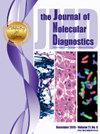形态学骨评分作为分子谱分析成功的预测工具。
IF 3.4
3区 医学
Q1 PATHOLOGY
引用次数: 0
摘要
含骨肿瘤标本的脱钙有助于在组织学处理前软化组织。然而,它会导致核酸降解,导致下一代测序(NGS)失败,阻碍患者的诊断解决方案。本文描述的形态学骨评分(MBS)优化了脱钙组织样本的评估,从而提高了分子遗传学实验室的诊断准确性和成本效率。MBS使用五个关键形态学特征构建,评分从0到11,反映组织损伤程度从低到高,并与每个细胞的核酸产量成正比。MBS阈值可以根据具体分析的目的进行调整,同时在灵敏度和准确性之间取得平衡。在我们的NGS工作流程中,使用MBS将低质量样品从下游处理中排除,每个样品节省了1,500美元。由于MBS在评估病理样本时的客观性和一致性确保了可靠和可重复的结果,因此它为精确肿瘤学中最大化组织利用和优化下游分析提供了一种具有成本效益的方法。通过额外的验证,该工具可以在将形态特征转换为可测量单位的计算模型中实现。本文章由计算机程序翻译,如有差异,请以英文原文为准。

Morphological Bone Score as a Predictive Tool for Molecular Profiling Success
Decalcification of bone-containing tumor samples serves to soften tissues before histologic processing. However, it can lead to nucleic acid degradation, resulting in next-generation sequencing failures that impede diagnostic solutions for patients. The Morphological Bone Score (MBS) described herein optimizes the assessment of decalcified tissue samples, consequently improving both diagnostic accuracy and cost efficiency in molecular genetic laboratories. The MBS, constructed using five key morphologic features, assigns scores from 0 to 11, reflecting low to high tissue damage and direct proportionality with nucleic acid yields per cell. The MBS threshold can be adjusted depending on the aims of a specific analysis while balancing between sensitivity and accuracy. In our next-generation sequencing workflow, the exclusion of poor-quality samples from downstream processing using MBS led to a savings of $1500 per sample. The MBS provides a cost-effective approach for maximizing tissue utilization and optimizing downstream profiling in precision oncology because its objectivity and consistency in evaluating pathologic samples ensure reliable and reproducible outcomes. With additional verification, this tool could be implemented in computational models for converting morphologic features into measurable units.
求助全文
通过发布文献求助,成功后即可免费获取论文全文。
去求助
来源期刊
CiteScore
8.10
自引率
2.40%
发文量
143
审稿时长
43 days
期刊介绍:
The Journal of Molecular Diagnostics, the official publication of the Association for Molecular Pathology (AMP), co-owned by the American Society for Investigative Pathology (ASIP), seeks to publish high quality original papers on scientific advances in the translation and validation of molecular discoveries in medicine into the clinical diagnostic setting, and the description and application of technological advances in the field of molecular diagnostic medicine. The editors welcome for review articles that contain: novel discoveries or clinicopathologic correlations including studies in oncology, infectious diseases, inherited diseases, predisposition to disease, clinical informatics, or the description of polymorphisms linked to disease states or normal variations; the application of diagnostic methodologies in clinical trials; or the development of new or improved molecular methods which may be applied to diagnosis or monitoring of disease or disease predisposition.

 求助内容:
求助内容: 应助结果提醒方式:
应助结果提醒方式:


